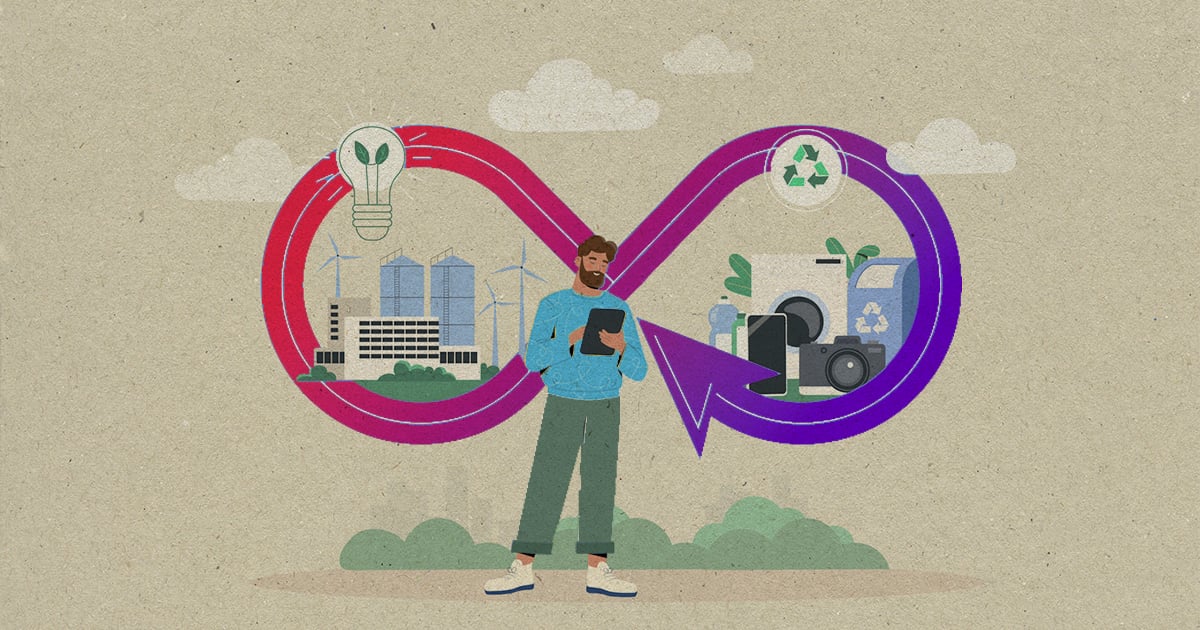
Carolyn Rivkees
Sustainability initiatives aren’t just responsible business practices—they’re smart investments.
According to research from Deloitte, 23 percent of consumers say they will switch to buying products from an organization that shares their values on environmental issues, and 42 percent have changed consumption habits themselves because of their stance on the environment. And based on research from the EY Global Institutional Investor Survey, 90 percent of investors say they now attach greater importance to ESG performance in their decision-making than before the Covid-19 pandemic. (ESG performance evaluates an organization's performance against sustainability metrics related to either environmental, social, or governance issues).
One way businesses tackle sustainability is through a circular business model. In this closed-loop system, resources are kept in use for as long as possible through recycling, refurbishment, and reuse.
We spoke to Kogod professor David Bartlett for his thoughts on how the circular economy ties into global sustainability and innovation.
Principles of the Circular Economy
The three main principles of a circular economy are: eliminate waste and pollution, circulate products and materials (use things rather than use them up), and regenerate nature (actually improve the environment). When designed thoughtfully and inclusively, a circular economy has the potential to protect the environment, boost economic productivity, and elevate social justice.
Circular-economy business models fall into two groups: those that foster reuse and extend service life through repair, remanufacture, upgrades, and retrofits; and those that turn old goods into as-new resources by recycling the materials.
A circular economy shifts our approach to assets. In a circular economy, biological materials are the only ones considered consumable, while technical materials are used—access to a product's service becomes more important than the product itself.
Common Misconceptions
The circular economy is the same as sustainability: Circularity contributes to a more sustainable world, but not all sustainability initiatives contribute to circularity. Circularity focuses on resource cycles, while sustainability is more broadly related to people, the planet, and the economy.
The circular economy is only for certain industries: The circular economy is relevant to all industries, from manufacturing to services, and can benefit all sectors of society. Bartlett said any organization could adopt circular economy principles and strategies to reduce waste, increase resource efficiency, and drive innovation.
“Leading companies in a range of major global industries have demonstrated the value-creating potential of the circular economy model,” explained Bartlett. He notes that equipment companies can generate profits by refurbishing old machinery and remanufacturing parts; fashion and apparel companies can burnish their brand reputations by promoting clothes recycling; and electronic manufacturers can gain favor with consumers, investors, and local communities through innovations in electronic waste management.
The circular economy is expensive and challenging to implement: While transitioning to a circular economy may require an upfront investment, it can ultimately lead to cost savings and greater efficiency. According to Bartlett, circular economies can result in reduced operating costs and increased profit margins stemming from water, energy, and materials conservation.
When looking at economies of scale, analysis shows that in Europe, putting in place a circular economy for buildings, transport, and food could create EUR 900 billion a year more than would be created without it in 2030.
Businesses stand to realize a range of benefits to start transitioning toward a circular economy and away from today’s current ‘take-make-waste’ model.”

David Bartlett
Professor of Management, Kogod School of Business
Business Benefits
In addition to reduced costs, businesses can enjoy heightened brand equity and improved reputation with consumers and other external stakeholders; increased value generation for ESG investors; and lower regulatory, legal, and reputational risks.
Bartlett also explained that circular economies could strengthen businesses’ ability to attract and retain talented employees—from employing workers with skills in sustainable product design to workers tasked with collecting and recovering recyclable materials.
Several studies also back up the idea that the circular economy can boost jobs—most of the research to date has emerged from Europe, where the circular economy is more advanced. The International Labour Organization projects the net creation of 18 million green jobs by 2030, including 4 million in manufacturing and 9 million in renewables and construction.
While there is still far to go to achieve these changes at scale, more and more businesses are committing to sustainable approaches. In response to the economic impact of the coronavirus pandemic, more than 50 global leaders, including CEOs of some of the world’s largest companies, policymakers, and other influential individuals worldwide, signed a joint statement in June 2020 calling for a transition to a circular economy. Leaders involved spanned fashion, food, healthcare, technology, mobility, electronics, and chemicals industries. In the plastics sector, more than 1,000 organizations have agreed upon a shared vision of a circular economy for plastics.
Stay up to date on more sustainable business practices by visiting Kogod's Sustainability News site.
